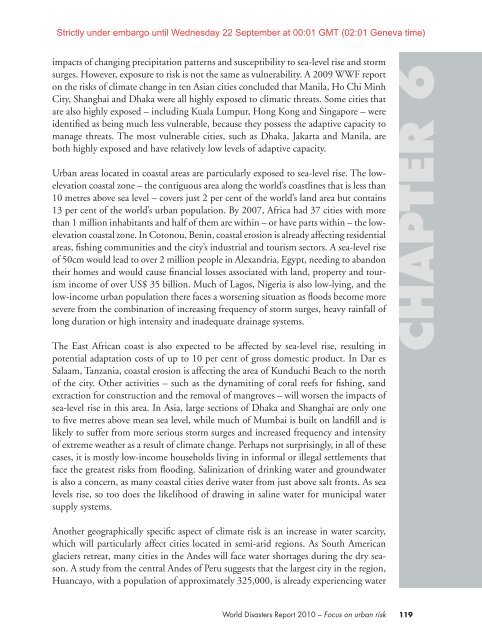chapter 4 - DRK
chapter 4 - DRK
chapter 4 - DRK
Create successful ePaper yourself
Turn your PDF publications into a flip-book with our unique Google optimized e-Paper software.
Strictly under embargo until Wednesday 22 September at 00:01 GMT (02:01 Geneva time)impacts of changing precipitation patterns and susceptibility to sea-level rise and stormsurges. However, exposure to risk is not the same as vulnerability. A 2009 WWF reporton the risks of climate change in ten Asian cities concluded that Manila, Ho Chi MinhCity, Shanghai and Dhaka were all highly exposed to climatic threats. Some cities thatare also highly exposed – including Kuala Lumpur, Hong Kong and Singapore – wereidentified as being much less vulnerable, because they possess the adaptive capacity tomanage threats. The most vulnerable cities, such as Dhaka, Jakarta and Manila, areboth highly exposed and have relatively low levels of adaptive capacity.Urban areas located in coastal areas are particularly exposed to sea-level rise. The lowelevationcoastal zone – the contiguous area along the world’s coastlines that is less than10 metres above sea level – covers just 2 per cent of the world’s land area but contains13 per cent of the world’s urban population. By 2007, Africa had 37 cities with morethan 1 million inhabitants and half of them are within – or have parts within – the lowelevationcoastal zone. In Cotonou, Benin, coastal erosion is already affecting residentialareas, fishing communities and the city’s industrial and tourism sectors. A sea-level riseof 50cm would lead to over 2 million people in Alexandria, Egypt, needing to abandontheir homes and would cause financial losses associated with land, property and tourismincome of over US$ 35 billion. Much of Lagos, Nigeria is also low-lying, and thelow-income urban population there faces a worsening situation as floods become moresevere from the combination of increasing frequency of storm surges, heavy rainfall oflong duration or high intensity and inadequate drainage systems.The East African coast is also expected to be affected by sea-level rise, resulting inpotential adaptation costs of up to 10 per cent of gross domestic product. In Dar esSalaam, Tanzania, coastal erosion is affecting the area of Kunduchi Beach to the northof the city. Other activities – such as the dynamiting of coral reefs for fishing, sandextraction for construction and the removal of mangroves – will worsen the impacts ofsea-level rise in this area. In Asia, large sections of Dhaka and Shanghai are only oneto five metres above mean sea level, while much of Mumbai is built on landfill and islikely to suffer from more serious storm surges and increased frequency and intensityof extreme weather as a result of climate change. Perhaps not surprisingly, in all of thesecases, it is mostly low-income households living in informal or illegal settlements thatface the greatest risks from flooding. Salinization of drinking water and groundwateris also a concern, as many coastal cities derive water from just above salt fronts. As sealevels rise, so too does the likelihood of drawing in saline water for municipal watersupply systems.Another geographically specific aspect of climate risk is an increase in water scarcity,which will particularly affect cities located in semi-arid regions. As South Americanglaciers retreat, many cities in the Andes will face water shortages during the dry season.A study from the central Andes of Peru suggests that the largest city in the region,Huancayo, with a population of approximately 325,000, is already experiencing waterWorld Disasters Report 2010 – Focus on urban risk119
















